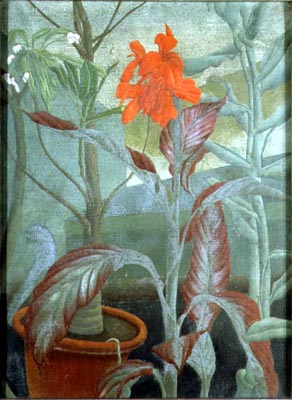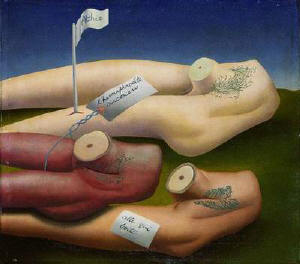|
|
| home | features | exhibitions | interviews | profiles | webprojects | gazetteer | links | archive | forum |
|
Ithell Colquhoun
Ithell Colquhoun (1906-1988) was an artist, poet and novelist. In addition, she was a practicing magician. She regarded all these activities as intimately related to each other, presenting different aspects of her quest to understand nature. For much of her adult life she lived and worked in Cornwall, drawn by a sense of connectedness with the landscape and with the local myths and traditions. Life and work Colquhoun was born in India of British parents, but returned to England as a child. She received her schooling at Cheltenham Ladies College and her formal training in art at the Slade School of Art in London. She had considerable powers of imagination, a strong sense of colour and a natural drawing ability. In 1928, in her final year at college, she was jointly awarded the Summer Prize for Composition, the most prestigious of all the Slade awards. This was for her painting of a biblical scene, Judith Showing the Head of Holofernes (now in the possession of the College Art Collections, London University). Following graduation she
travelled widely in Mediterranean countries, painting many watercolours of
scenes in Greece and Corsica. On her return to London she turned her
attention to making drawings and paintings of plants and flowers, often
emphasising the resemblance to sexual organs she found in bulbs and
flowers (eg Canna 1936 - below right). In 1936 she attended
the famous International Exhibition of Surrealism in London and later
joined the Surrealist Group which was active in London prior to the Second
World War. However, she had a considerable independent streak and fell
out with the leader of the group, ELT Mesens, in 1940 over her refusal to
give up her occult studies. This led to her exclusion from the group.
Between 1938 and 1942 she
painted a number of works using the surrealist ‘double image’ technique
made famous by Salvador Dali. The best known of these is Scylla
(1938 - below), now in the collections of the Tate Gallery. At first
sight, this is a pair of rocky pillars that rise out of the sea, but a
longer inspection shows that the pillars are based on the view the artist
had of her legs and lower torso as she lay in the bath. In 1939 she began
to experiment with decalcomania and other forms of automatism. That is,
using various methods of applying paint randomly to her canvas or paper
and then interpreting the resulting stains and marks. Automatism was
important because it enabled her to make connections between surrealism
and the occult.
For Colquhoun, sex was a driving, central force in all creation, having human, inorganic and divine components. Surrealism helped her make connections between all these aspects and to question conventional cultural and biological relationships between male and female. Many of her paintings of this period, such as The Pine Family (1942-below), now in the Israel Museum, Jerusalem, have an intensity that place them amongst surrealisms greatest set pieces of sexual confrontation seen from a female perspective. In these works, gender, gender roles and male/female relationships are the focus. In later life, her work
lost some of her initial intensity and took on a more poetic, mystical
view of life and our place in nature. She began to develop her ideas of
an intimate and harmonious association between Woman and nature. This is
evident not only in her art, but also in her writings and her occult
activities. It runs, for example through her novel Goose of Hermogenes
and in one of her collections of poetry, Grimoire of the Entangled
Thicket. Today, we might call this Goddess Spirituality and it has
become an inspirational metaphor for many women..
Colquhoun’s personal magical researches led her to membership of a number of occult societies. The included the Ordo Templi Orientis and the Order of the Keltic Cross. She was also a member of Druidical Orders and a branch of the Theosophical Society. In 1975 she published The Sword of Wisdom, a biography of MacGregor Mathers, the founder of the occult order The Hermetic Order of the Golden Dawn. This was an historically important group that at one time included Aleister Crowley and WB Yeats amongst its members. As her magical activities developed, she adopted a magical motto, Splendidior Vitro (‘more sparkling than crystal’) and, from 1962 onwards, ceased to sign her works with her signature, using instead a sigil formed from the initials of her magical name: art and magic had become indistinguishable. She continued to experiment with artistic techniques, and in later life, turned increasingly to collages and constructions. In these, she frequently incorporated the debris of everyday life such as plastic coffee cups and fast food containers into works that display simple yet effective transformations. Although Colquhoun lived in the twentieth century culture, informed and influenced by surrealism, she was also part of a tradition that can be traced back to the Neoplatonic idea of the World Soul, through the Anima Mundi of the mediaeval hermetic philosophers to Theosophy and the teachings of the contemporary occult groups Hers was, at heart, a pantheistic world view in which the divine, the human and the natural are all fused together in a unity that underlies its surface diversity.
Colquhoun and Cornwall During the 1940s she spent increasing periods of time Cornwall, initially purchasing a very primitive building in the Lamorna Valley. This accommodation, which lacked electricity and running water, could only be inhabited in the summer months. She moved into a permanent studio in Paul in 1959. This became her home for the rest of her life. hut Her book, The Living Stones (1957) gives an account of why she chose to settle in Cornwall. Drawn to places she perceived as significant and sacred, she felt a profound kinship with the Cornish countryside, revering the life-force that she experienced. Writing of the Lamorna Valley, she declared: “I am identified with every leaf and pebble, and any threatened hurt to the wilderness of the valley seems to me a rape” This animism is revealed also in the sketches and vignettes that illustrate the volume. She saw human and animal forms in the rocks and vegetation: the fork of a tree is, at the same time, a torso with twisting limbs; a sea-stack is an unmistakable phallus; fungi and granite boulders possess rounded female forms. The title, The Living Stones (and, indeed the title of an earlier book about her travels in Ireland, The Crying of the Wind), says it all: natural phenomena breathe with life. Colquhoun regarded stone circles, holy wells and other landscape features such as caves as ‘geysers of energy’. In works such as Dance of the Nine Opals (1942) and Sunset Birth (c.1942) a depiction of the Men-an-Tol megalithic monument, she painted some of the forces she sensed at these sites and in a suite of delicate watercolours, Dance of the Nine Maidens (1940), she recorded the legend that stone circles were the transmogrified remains of girls who had danced on the Sabbath and been punished for it. She entered into the cultural life of Cornwall, becoming a member of the West Country Writers Association and the Newlyn Society of Artists, and regularly taking part in their activities.
Richard Shillitoe July 2006
For further information on Colquhoun, her publications and public galleries where her work can be seen, please visit www.ithellcolquhoun.co.uk
|
|
|




